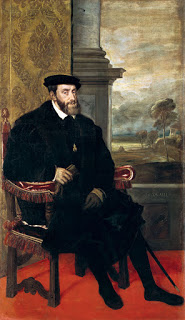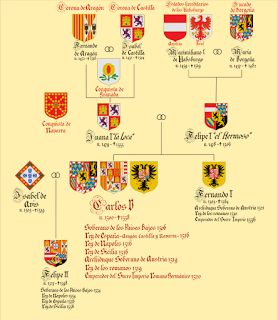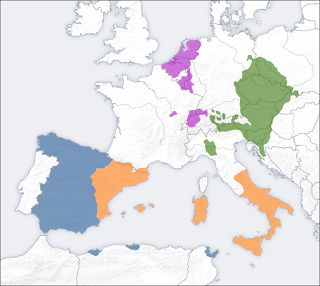Social Sciences



- This Day In History: Charles V's Abdications
Hello I'm María, today I'm going to explain Charles abdications and later life. Today but 450 years ago Charles V abdicated his German possessions and the title of emperor on his brother Ferdinand. Charles abdicated the parts of his empire...
- This Day In History: Charles I's Coronation And The End Of The Revolt Of The Comuneros
Hey friends! It's Lucía. Today is my turn to explain what happened years and years ago. Yes! This is a new chapter of... THIS DAY IN HISTORY! And as you have seen in the title, today we have double event. FIRST EVENT: CHARLES I'S CORONATION....
- This Day In History: Elizabeth Of France's Death
I'm inaugurating a new section on the blog called "This day in history". It consists of explaining some historical events happened on a specific date in the past. You can contribute with your own events, but respecting some rules: the events you elect...
- 22nd Of September 2015
Hi! I'm Manal, and today I'm going to explain you what we have learnt in social sciences.At first, Paqui has showed us a Charles' family image, to understand better his family, because they married with people of their own family, so...
- 21st September
Hello, I'm Andrei. Today has been the third day of class of Social Sciences. At the beginning of the lesson Paqui has drawn us a Family Tree of the Catholic Monarchs. The Catholic Monarchs had 5 children and the names of their children were: Isabella,...
Social Sciences
17th September
Hi everyone. Today has been the second day of Social Sciences, but for me, and I don?t know if for everyone else too, this lesson has been the first one, because the other one was only to meet each other and to talk a little bit about how was going to be this term. In my opinion, the blog is a very good idea, because we can check and review every content we?ve studied, but this reply is not to say my opinion. Well, perhaps in some aspects, but I think this is not the best moment.
At the beginning of the lesson, Paqui has showed us her new friend called Andrei. Apparently, the ?real? Andrei gave her his wrong email address, and Paqui has contacted with another man who?s called with the same name. It seems that this is not the first time this man appears in Paqui?s inbox, because in 2ndESO Andrei did the same. Well, who knows, perhaps this is the beginning of a beautiful friendship between Paqui and him.
(Mini P.D.: Andrei, don?t forget the name of your email account anymore.)
Today we?ve started with ?unit 1?. In reality, ?The 16th and 17thcenturies? are units 8 and 9 from the 3rd ESO?s book, but as we didn?t learn it in 2nd ESO, we?re studying it now, but joined in only one theme. I prefer to study it and to go on with the 4th ESOS?s content better than forget about it and start learning something that doesn?t connect with our knowledge of 2nd ESO, I don?t know if you follow what I want to say.
Anyway. We?ve copied the index of this unit full of kings, reigns, territories and, naturally, history. The first part talks mostly about the 16thcentury, where we can see the Hispanic Monarchy under the Habsburg dynasty with Charles I and Philip II, and also the 17th century decline with Charles II, Philip III and IV?s. In this first part we are going to work in groups of 3/4 people and what we have to do is a project which consists of a board game. I think we?re going to have a lot of fun, playing and learning at the same time.
In the second part of the index, there is information about the 17th century, like its crisis, the Thirty Year?s War, the absolute monarchy, the English revolutions and some content of culture and art. In the Baroque Art, we have to prepare an individual project. I think it will be interesting.
We?ve also started talking about Charles I, his family, the territories he had and some curious things about his life. Did you know that he became king at the age of five? No? Neither did I, so don?t worry. I can?t understand why people let children to govern a kingdom, even if they were oriented by his court or the people who had to make the decisions on the child king behalf.

Source: https://es.wikipedia.org/wiki/Carlos_I_de_Espa%C3%B1a#/media/File:Titian_-_Portrait_of_Charles_V_Seated_-_WGA22964.jpg
As I?ve heard in class, Charles? family was a little bit unlucky. Why? Well, a lot of members died, but not because of the advanced age. I mean, perhaps there was someone who did, but the rest passed away because of illnesses, or I don?t know why, but I?m sure that if Paqui?s said that they had no luck; it is because there was something here that didn?t work.
Here is the Family Tree that Paqui has showed us in class.

Source: https://upload.wikimedia.org/wikipedia/commons/thumb/d/dc/Herencia_del_Emperador_Carlos_V%2C_Carlos_I_como_Rey_de_Espa%C3%B1a.svg/700px-Herencia_del_Emperador_Carlos_V%2C_Carlos_I_como_Rey_de_Espa%C3%B1a.svg.png
Well, as I was saying (sorry, I expand on very frequently), some members of Charles? family died, so Charles I inherited a lot of territories like the Indies, west of Hispania, some territories in the north of Africa and the Canary Islands from his mother Joanna the Mad, east of Hispania, Sardinia, Sicily and Naples from his grandfather Ferdinand of Aragón, Burgundies territories from his father Philip the Handsome and Austria territories from his other grandfather Maximilium of Habsburg.

Source: https://upload.wikimedia.org/wikipedia/commons/c/c7/Charles_I_and_V_empire.png
We?ve seen superficially the conquest of the American territories, the Aztecs, the Incas, etc. In the glossary, we?ve copied some words like hegemony and supremacy. The difference between them is that hegemony is the political, economic, or military predominance or control of one state over others and supremacy is the domination of one group over another one.
And with this, I end my journal. See you the next time. Thanks for reading.
- This Day In History: Charles V's Abdications
Hello I'm María, today I'm going to explain Charles abdications and later life. Today but 450 years ago Charles V abdicated his German possessions and the title of emperor on his brother Ferdinand. Charles abdicated the parts of his empire...
- This Day In History: Charles I's Coronation And The End Of The Revolt Of The Comuneros
Hey friends! It's Lucía. Today is my turn to explain what happened years and years ago. Yes! This is a new chapter of... THIS DAY IN HISTORY! And as you have seen in the title, today we have double event. FIRST EVENT: CHARLES I'S CORONATION....
- This Day In History: Elizabeth Of France's Death
I'm inaugurating a new section on the blog called "This day in history". It consists of explaining some historical events happened on a specific date in the past. You can contribute with your own events, but respecting some rules: the events you elect...
- 22nd Of September 2015
Hi! I'm Manal, and today I'm going to explain you what we have learnt in social sciences.At first, Paqui has showed us a Charles' family image, to understand better his family, because they married with people of their own family, so...
- 21st September
Hello, I'm Andrei. Today has been the third day of class of Social Sciences. At the beginning of the lesson Paqui has drawn us a Family Tree of the Catholic Monarchs. The Catholic Monarchs had 5 children and the names of their children were: Isabella,...
